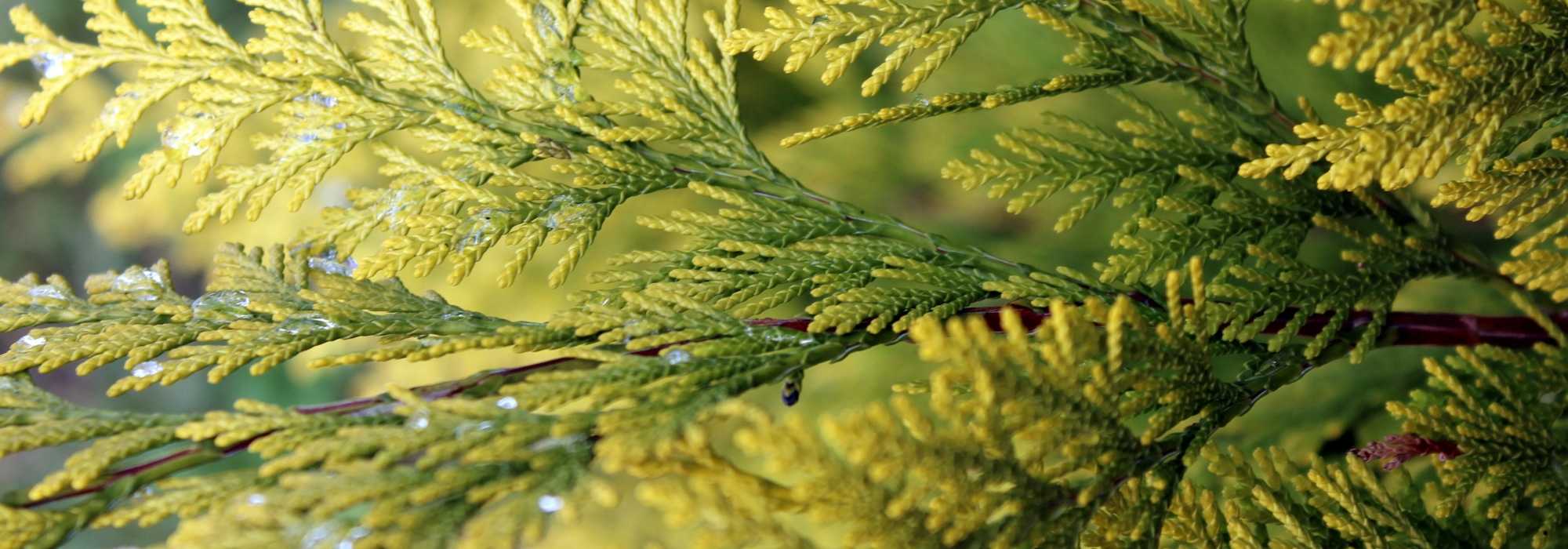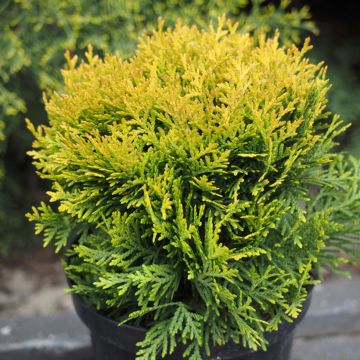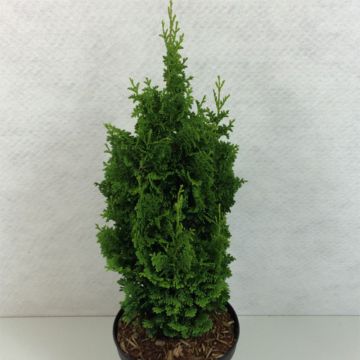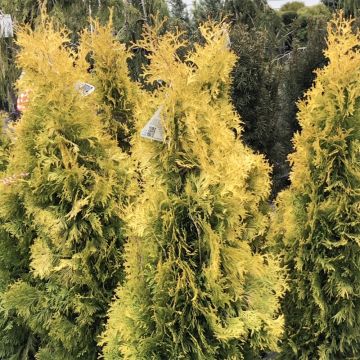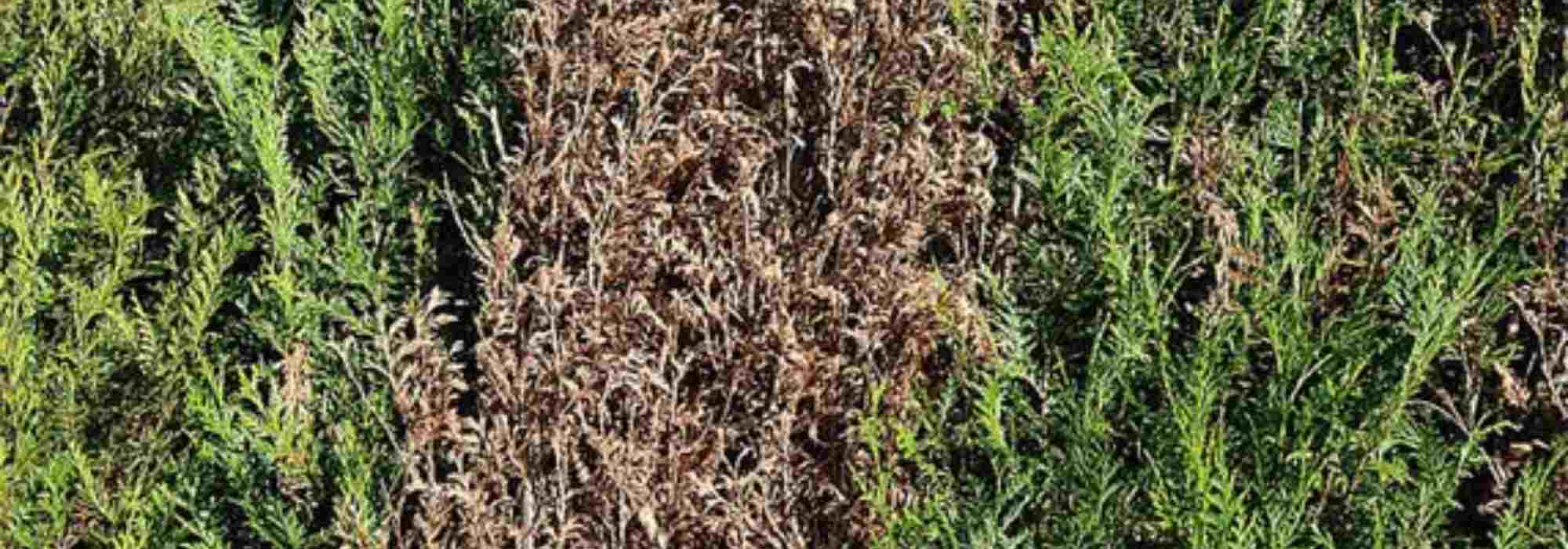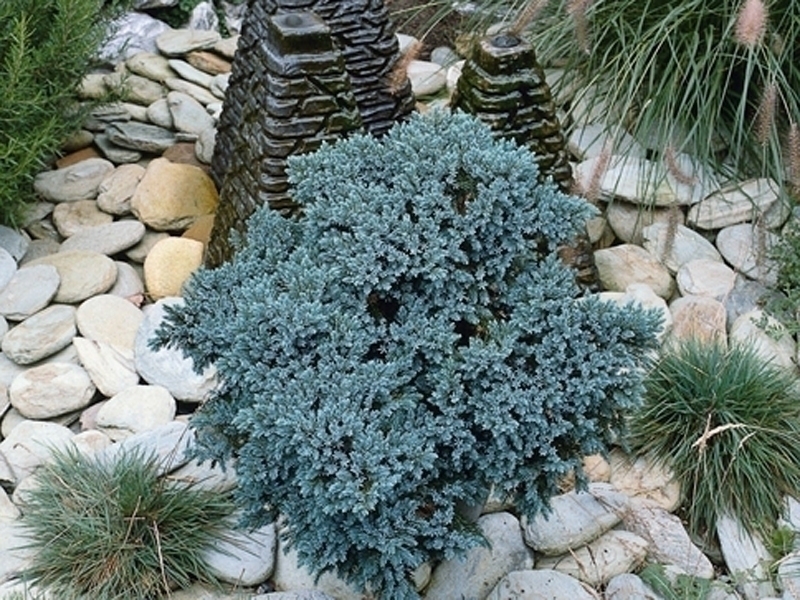

Thuja orientalis Fleck - Oriental Thuja
Thuja orientalis Fleck - Oriental Thuja
Thuja orientalis Fleck
Oriental Thuja
Special offer!
Receive a €20 voucher for any order over €90 (excluding delivery costs, credit notes, and plastic-free options)!
1- Add your favorite plants to your cart.
2- Once you have reached €90, confirm your order (you can even choose the delivery date!).
3- As soon as your order is shipped, you will receive an email containing your voucher code, valid for 3 months (90 days).
Your voucher is unique and can only be used once, for any order with a minimum value of €20, excluding delivery costs.
Can be combined with other current offers, non-divisible and non-refundable.
Why not try an alternative variety in stock?
View all →This plant carries a 24 months recovery warranty
More information
We guarantee the quality of our plants for a full growing cycle, and will replace at our expense any plant that fails to recover under normal climatic and planting conditions.
Would this plant suit my garden?
Set up your Plantfit profile →
Description
Thuja orientalis 'Fleck' is a variety of Oriental conifer that is interesting for its egg shape and particularly limited growth. It is a true miniature conifer that measures less than a metre in height and therefore integrates well in the foreground of a bed. It will also be perfect in a rock garden. With its evergreen foliage of beautiful green punctuated with white shoots, it is decorative all year round. Hardy and undemanding in terms of soil type, it thrives in full sun, or even partial shade.
Thuja orientalis (synonym Platycladus orientalis), also known as Chinese Conifer or Oriental Thuja, is sometimes called Tree of Life, due to its longevity and resilience. It is an evergreen conifer of the Cupressaceae family. Native to China, this species is found naturally from Iran to Japan. In its natural habitat, the tree reaches a height of 12 to 20 metres (39 to 66 feet), adopting a beautiful pyramid shape, with spreading ascending branches that start from the base of the trunk. Its evergreen foliage is pleasantly fragrant. It is a perfectly hardy species, well adapted to temperate climates and fairly poor, even dry soils. As it tolerates pruning well, this conifer is often used as a hedge. Its fragrant wood is used in construction work and as incense in Buddhist temples.
The 'Fleck' variety stands out for its very slow growth (only 5 to 7 cm (2 to 3in) per year) and its miniature size. After 10 years, it reaches a height of 50 to 70 cm (20 to 28in) with a spread of 30 to 40 cm. A bit disorderly at first, it eventually takes on a regular egg shape, giving it a very decorative sculptural appearance. This conifer has green foliage, with some white shoots, consisting of flattened branches arranged in planes and covered with tiny scale-like leaves measuring 3 mm (1in) in length. Overlapping each other, the leaves give the branchlets a flat appearance, with a predominantly vertical arrangement. This Thuja is adorned with cute little grey-green cones at the ends of the branches.
Oriental Thuja 'Fleck' will find a place in a small garden, within a bed, as it is really too small to be planted in isolation. It can adorn a sunny rock garden as its graceful shape will be perfect in the heart of a rockery. It will also fit perfectly in a contemporary garden, where its sculptural design will be highlighted. In a bed, it can be associated with plants that are not too tall to avoid smothering it. The small Photinia fraseri 'Chico', which forms a green ball with reddish-bronze spring shoots, will be perfect in this role, as will the charming Viburnum davidii with its dark green, highly veined leaves and white flowering in JuneTo complete this scene with a touch of brightness, tiny Thujopsis dolobrata 'Solar Flare', with its yellow foliage as delicate as a fern.
Thuja orientalis Fleck - Oriental Thuja in pictures


Plant habit
Foliage
Botanical data
Thuja
orientalis
Fleck
Cupressaceae
Oriental Thuja
Cultivar or hybrid
Other Thuya - Thuja
View all →Planting and care
Thuja orientalis 'Fleck' is best planted from September to November and from February to April in deep, ordinary, but loose and not too heavy soil, slightly acidic, neutral or even slightly chalky. Once well-rooted, it withstands drought quite well. It is not very demanding in terms of exposure, even though it prefers a sunny or semi-shaded position to develop well. Soak the root ball well before planting. You can add organic fertiliser at planting and water generously in the first few years and in case of abnormally prolonged drought. In very poor soil, you can apply a special conifer fertilizer every year in April and weed the soil in summer. This hardy conifer (down to -25°C (1°F) at least) does not require pruning, especially since it grows very slowly!
Planting period
Intended location
Care
Planting & care advice
This item has not been reviewed yet - be the first to leave a review about it.
Similar products
Haven't found what you were looking for?
Hardiness is the lowest winter temperature a plant can endure without suffering serious damage or even dying. However, hardiness is affected by location (a sheltered area, such as a patio), protection (winter cover) and soil type (hardiness is improved by well-drained soil).

Photo Sharing Terms & Conditions
In order to encourage gardeners to interact and share their experiences, Promesse de fleurs offers various media enabling content to be uploaded onto its Site - in particular via the ‘Photo sharing’ module.
The User agrees to refrain from:
- Posting any content that is illegal, prejudicial, insulting, racist, inciteful to hatred, revisionist, contrary to public decency, that infringes on privacy or on the privacy rights of third parties, in particular the publicity rights of persons and goods, intellectual property rights, or the right to privacy.
- Submitting content on behalf of a third party;
- Impersonate the identity of a third party and/or publish any personal information about a third party;
In general, the User undertakes to refrain from any unethical behaviour.
All Content (in particular text, comments, files, images, photos, videos, creative works, etc.), which may be subject to property or intellectual property rights, image or other private rights, shall remain the property of the User, subject to the limited rights granted by the terms of the licence granted by Promesse de fleurs as stated below. Users are at liberty to publish or not to publish such Content on the Site, notably via the ‘Photo Sharing’ facility, and accept that this Content shall be made public and freely accessible, notably on the Internet.
Users further acknowledge, undertake to have ,and guarantee that they hold all necessary rights and permissions to publish such material on the Site, in particular with regard to the legislation in force pertaining to any privacy, property, intellectual property, image, or contractual rights, or rights of any other nature. By publishing such Content on the Site, Users acknowledge accepting full liability as publishers of the Content within the meaning of the law, and grant Promesse de fleurs, free of charge, an inclusive, worldwide licence for the said Content for the entire duration of its publication, including all reproduction, representation, up/downloading, displaying, performing, transmission, and storage rights.
Users also grant permission for their name to be linked to the Content and accept that this link may not always be made available.
By engaging in posting material, Users consent to their Content becoming automatically accessible on the Internet, in particular on other sites and/or blogs and/or web pages of the Promesse de fleurs site, including in particular social pages and the Promesse de fleurs catalogue.
Users may secure the removal of entrusted content free of charge by issuing a simple request via our contact form.
The flowering period indicated on our website applies to countries and regions located in USDA zone 8 (France, the United Kingdom, Ireland, the Netherlands, etc.)
It will vary according to where you live:
- In zones 9 to 10 (Italy, Spain, Greece, etc.), flowering will occur about 2 to 4 weeks earlier.
- In zones 6 to 7 (Germany, Poland, Slovenia, and lower mountainous regions), flowering will be delayed by 2 to 3 weeks.
- In zone 5 (Central Europe, Scandinavia), blooming will be delayed by 3 to 5 weeks.
In temperate climates, pruning of spring-flowering shrubs (forsythia, spireas, etc.) should be done just after flowering.
Pruning of summer-flowering shrubs (Indian Lilac, Perovskia, etc.) can be done in winter or spring.
In cold regions as well as with frost-sensitive plants, avoid pruning too early when severe frosts may still occur.
The planting period indicated on our website applies to countries and regions located in USDA zone 8 (France, United Kingdom, Ireland, Netherlands).
It will vary according to where you live:
- In Mediterranean zones (Marseille, Madrid, Milan, etc.), autumn and winter are the best planting periods.
- In continental zones (Strasbourg, Munich, Vienna, etc.), delay planting by 2 to 3 weeks in spring and bring it forward by 2 to 4 weeks in autumn.
- In mountainous regions (the Alps, Pyrenees, Carpathians, etc.), it is best to plant in late spring (May-June) or late summer (August-September).
The harvesting period indicated on our website applies to countries and regions in USDA zone 8 (France, England, Ireland, the Netherlands).
In colder areas (Scandinavia, Poland, Austria...) fruit and vegetable harvests are likely to be delayed by 3-4 weeks.
In warmer areas (Italy, Spain, Greece, etc.), harvesting will probably take place earlier, depending on weather conditions.
The sowing periods indicated on our website apply to countries and regions within USDA Zone 8 (France, UK, Ireland, Netherlands).
In colder areas (Scandinavia, Poland, Austria...), delay any outdoor sowing by 3-4 weeks, or sow under glass.
In warmer climes (Italy, Spain, Greece, etc.), bring outdoor sowing forward by a few weeks.








































